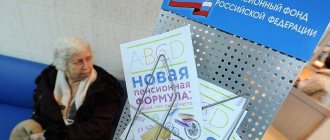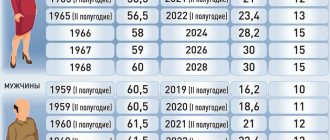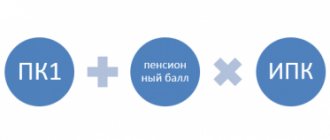The main unit of measurement of pension benefits is the pension point. And the changes came into force in 2015, when the new Law on Insurance Pensions was introduced. Consequently, the more points accumulated for work experience, the larger the pension.
And given the fact that, in addition to periods of work, the length of service may include periods of a non-insurance nature, you can add a few points to your existing number.
Since the largest number of points are accumulated during periods of child care, it is in this light that the question of replacing work experience with points and subsequent recalculation of the pension benefit is relevant.
But such a recalculation is not always a benefit for the woman, leading to an increase in the pension benefit. If periods of care are replaced by pension points, then non-insurance periods are not taken into account in the length of service, and accordingly, one of the components of the pension is reduced.
We are talking about the length of service coefficient, which is calculated on the basis of the total length of service worked out by the citizen before 01/01/2002. For a 20-year period, a coefficient of 0.55 is set for women and for each year over 20 years, 0.01 is added (the maximum increase is 0.75).
It is for this reason that many women who turn to Pension Fund employees to recalculate insurance benefits for children are refused. The fact is that in their situation this action is not profitable and leads to a decrease in the size of the pension.
But we will analyze exactly those situations when it is actually beneficial for a woman to recalculate her pension for children.
Conditions for increasing pensions for Soviet service
The period of labor activity of a citizen participating in the compulsory pension insurance system is conditionally divided into several segments:
- up to 1990 (inclusive);
- from 1991 to 2001 (inclusive);
- from 2002 to 2014 (inclusive);
- since 2015
The period up to and including December 31, 2001 is conditionally counted as Soviet service. When assigning a pension, all the time during which a person worked is taken into account. The pensioner’s payment file may not contain documentary evidence of work for this period, since centralized personalized records began to be kept only in 2002.
Recipients of old-age or disability pensions may apply for a recalculation of their pension taking into account Soviet service.
The citizen must personally submit an application to the Pension Fund and confirm the work periods by providing the documentation missing in the payment file. He is required to recalculate his pension upward, taking into account:
- labor activity until 2002;
- preferential length of service during the USSR;
- non-insurance periods.
When taking into account Soviet service for recalculating pensions, the Pension Fund employee takes into account the periods:
- employment as an employee or worker;
- the work of evacuated citizens on collective farms during the Great Patriotic War (WWII);
- individual labor activity;
- creative activities (cinematography, fine arts, literature);
- work as the chairman of a collective farm or his deputy on the direction of Soviet or party bodies;
- activities as a member of the fishing cooperative artel;
- work as a labor obligation;
- employment by members of collective farms and other cooperative organizations;
- service in paramilitary security, special communications agencies or in a mine rescue unit;
- other work if the person made contributions to state social insurance.
Periods of temporary disability, studies in secondary specialized and higher educational institutions, service in the armed forces and other law enforcement agencies, as well as stay in partisan detachments and in captivity are counted into the Soviet work experience for subsequent recalculation.
The total length of service includes the time spent actually caring for a group I disabled person who has become incapacitated due to a military injury.
The pension for length of service in Soviet times can be increased by including periods that during the USSR were included in preferential length of service. For recalculation, the following work is taken into account:
- with harmful, dangerous and difficult working conditions (Lists 1 and 2);
- in elected positions in Komsomol and party organs, political departments and directorates;
- on water transport;
- in the regions of the Far North (RKS) and in equal territories (TKS);
- in leprosy and anti-plague institutions.
We suggest you read: How to calculate alimony from a non-working person
The time before retirement, when a citizen did not work or could not work due to objective circumstances, refers to the so-called “non-insurance periods”. For each full year, the applicant is entitled to a recalculation in the form of 1.8 PB:
- caring for a disabled person of group 1 and a disabled child;
- criminal punishment if the person was later rehabilitated;
- service in the army as a conscript soldier;
- receiving unemployment benefits;
- staying with a diplomatic spouse on the territory of another state (maximum duration – 5 years);
- moving to another area with a military spouse in the absence of the opportunity to get a job in the specialty;
- care for elderly people over 80 years of age.
Recalculation when caring for a child from birth to 1.5 years occurs taking into account the order of birth of the baby:
- for the first – 1.8 PB per year;
- the second – 3.6 PB per year;
- third and fourth - 5.4 PB per year.
The maximum duration of child care time taken into account in the length of service is limited to 6 years - one and a half years for each child. The maximum possible number of PBs is 24.3. For confirmation, you must provide birth certificates of children.
How and where to apply for a new settlement
To apply you need:
- Fill out the form in person at the Pension Fund (you can pre-register by phone);
- contact the MFC (in case of joint actions of these government bodies);
- fill out the electronic form on the State Services website (5 days after review, you need to bring the original documents to the Pension Fund);
- send a registered letter with enclosed notarized copies of all necessary papers.
Postal delivery is convenient only if the pensioner is in another city or region. Sending takes a long time and does not guarantee reliable receipt of the letter by government authorities.
Recalculation must be made within 30 days
Package of documents:
- direct application;
- passport;
- SNILS;
- child’s birth certificate (if lost, you can obtain a certificate from the registry office);
- children's passports (military ID, certificate or other document confirming that they have reached the age of 1.5 years).
Sometimes a note indicating receipt of a civil passport is placed on the birth certificate. In this case, no additional documents are required. The review period is no more than 5 working days.
You can apply for a recalculation at any time. There are no restrictions on this matter. The legalized additional payment will be made starting next month. When issuing a refusal, the Pension Fund is obliged to notify the citizen in writing.
The concept of coefficient based on experience and earnings
The length of service is used when calculating pensions for the period before 2002 and is an indicator of the employee’s total length of service. The earnings coefficient is an individual indicator of a citizen, determined for a month out of any 60 consecutive months within 10 years of service.
In this case, breaks are not taken into account. To do this, it is necessary to divide the salary amount accepted for calculating the pension by the average monthly earnings.
What is the experience coefficient?
Valorization
This is a recalculation of old-age payments for the Soviet period. It affected all senior citizens – those with mixed experience and those who are already pensioners. At the same time, all of them automatically receive an increase of 10%, and for those who have experience before 1991, 1% for each year.
Since 2001, pension payments have increased by 352 rubles and by the beginning of 2002 its average amount was 1,600 rubles.
Where is parental leave included?
A regular old-age insurance pension is largely determined by how and how much the future pensioner worked, and most importantly, how much he earned. At the same time, several pension systems have changed over the history of Russia, each of which differed from the previous one. The current legislation must somehow take all this into account so that the length of service gained is reflected in the amount of payment.
And if with periods of work everything is more or less clear (before 2002, length of service and average salary are important, after that - length of service and contributions), then with other periods everything is not so obvious. For example, study is included in the length of service to a very limited extent, but the army is included completely.
Such periods are called non-insurance periods - some are included in the length of service and give the right to pension points, and some are not. The period of parental leave is included in the insurance period and gives the right to additional pension points. But in fact there are a lot of restrictions:
- This must be a parental leave issued at the official workplace. For mothers who gave birth to children and cared for them without working, additional work experience is not provided;
- the length of service includes no more than 1.5 years for each child and no more than 6 years for all children;
- In order for additional length of service and pension points to be taken into account, the mother (or the person who went on parental leave) must have worked periods before or after such leave. But this rule is general for all non-insurance periods, and in this case it is generally impossible to go on vacation without work.
For the year of caring for the first child, 1,8
pension points, the second -
3.6
points, and the third -
5.4
points. But here there is an additional condition. The fact is that the mother does not have to go on parental leave - she can continue to work while the father or grandmother is caring for the child (with or without taking leave). And if, for example, the mother did not officially care for the first child, but took leave for the second, she will be awarded points for it as for the first. That is, it is the periods of child care that are counted, not the children themselves.
On the other hand, if twins are born in a family, and the mother takes leave to care for both children, then in a year she will receive pension points as for two (as is the case if the periods coincide). For example, if this is her first vacation, then over the year she will be awarded 1.8 points for the first child and 3.6 points for the second - a total of 5.4 points.
This rule applies to all periods
– and before 2001, and from 2002 to 2014, and since 2015.
Separately, it is worth mentioning the preferential length of service
for representatives of certain professions - doctors and teachers. For them, the period of child care is included in such length of service (that is, taken into account when calculating length of service) only if the leave began from 1982 to October 6, 1992. Since then, special experience includes only periods of work.
Converting work experience into pension points
Number of pension points = amount of pension capital / cost of 1 PB (as of January 1, 2015).
In order to determine the amount of pension capital used for recalculation, it is necessary to make a series of calculations: in compliance with the following algorithm:
- Determine the experience coefficient (SC).
- Calculate the average monthly earnings coefficient (AMC).
- Calculate the amount of the estimated pension (RP).
- Carry out valorization.
- Apply a correction factor taking into account the indexations made.
We suggest you read: Worked without a contract, didn’t get paid, what to do
The value of the SC depends on the number of years of Soviet service. For men who have worked less than 25 years and women whose work experience does not exceed 20 years, the SC is 0.55. For each additional year above the established value, the applicant is entitled to an increase of 0.01.
Please note that the law limits the maximum value of the SK. Regardless of gender, length of service and nature of activity, it cannot exceed 0.75.
Example:
- The man has an official work experience of 16 years. Its SC will be 0.55.
- The woman worked for 23 years. Its SC is 0.58 (0.55 0.01 x 3 = 0.58).
- The woman’s work experience is 42 years. SC will be equal to 0.75. (0.55 0.01 x 22 = 0.77, which is more than the legally established indicator).
To determine the SSC, it is necessary to have data for any 60 months of employment. Having determined the average monthly income, the resulting value must be divided by the average salary for 2001–2002. in Russia (1,494.5 rubles). Regardless of the result obtained, the maximum ratio value is limited to 1.2. The exception is citizens who have experience in the RKS and PKS. Their KSZ varies from 1.4 to 1.9.
Example:
- The average citizen’s earnings for the selected period of employment was 1,600 rubles. KSZ = 1.07 (1,600 / 1,494.5 = 1.07).
- The average salary of the applicant for the selected time is 2,100 rubles. The KSZ will be 1.2 (2,100 / 1,454.5 = 1.4, which is higher than the legally established value).
- The average salary of a citizen with northern experience was 2,600 rubles. KSZ = 1.7 (2,8600 / 1,494.5 = 1.7).
RP = SK x KSZ x 1,671 – 450, where:
- 1,671 – average salary in the country for December 2001;
- 450 is the basic pension amount, which is determined by the law on labor pensions No. 173-FZ (12/17/2001).
The value (SC x KSZ x 1,671) cannot be less than 660. If during the calculation the amount received is lower, the value of the RP is determined at the minimum level - 210 rubles.
RP = (SK x KSZ x 1,671 – 450) x St, where:
- ST for women = length of service before 2002, divided by 20;
- St. for men = length of service until 2002, divided by 25.
We invite you to read: Dismissal due to staff reduction - step-by-step instructions, sample order
Important: if (SC x KSZ x 1,671) is less than 660, the value of 210 rubles is used in the calculation.
Example:
- A man has SV = 0.55, KSZ = 1.10. RP will be 560.96 rubles: (0.55 x 1.10 x 1,671) – 450 = 560.96.
- A woman has SF = 0.60 (25 years of experience), KSZ = 1.1. RP will be 816.08: (0.60 x 1.10 x 1,671 – 450) x (25 / 20) = 816.08 rub.
The resulting value of the estimated pension is subject to a one-time increase - valorization. 10% is added to the RP amount. The valorization of a pension, taking into account Soviet experience - up to 1991 - involves an additional increase of 1% for each full year of work.
Example:
- RP = 600 rub. Experience before 1991 – 0 years. The valorization amount is 60 rubles. (600 x 10% = 60).
- RP = 600 rub. Experience before 1991 – 14 years. The valorization amount will be 144 rubles: 600 x (10% 1% x 14) = 600 x 14% = 144 rubles.
The valorization of pension payments occurred for the first time on January 1, 2010. It affected all Russians - pension recipients who had work experience before 2002. The pension supplement was issued automatically, taking into account the information in the payment file. The goal is to recalculate payments to citizens whose pensions were accrued during Soviet times.
How to recalculate a pension taking into account work in Soviet times
The formula for calculating a pension for Soviet service allows you to determine the number of pension points earned by a citizen up to 2001 inclusive. To convert into points, the amount of the estimated capital is divided by the cost of one PB on January 1, 2015, since from this date another pension reform was carried out and the IPC began to be used when calculating pension payments.
Example:
- The PB value as of 01/01/2015 was 64.1.
- PC = 4500 rub.
- The number of IPCs will be 70.20 (4,500 / 64.1 = 70.20).
The increase in pension for Soviet service will be equal to 5,720.60 (70.20 x 81.49 = 5,720.60), where 81.49 is the cost of PB as of January 1, 2019.










